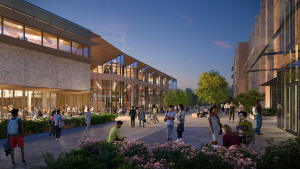Across the country many university and college campuses are starting to show their age.
There is approximately $8.4 billion in deferred maintenance on Canadian campuses, as infrastructure built in the 1960s and 1970s shuffles slowly to the end of its working days.
But where there are clever and talented designers, there is life.
In the Buildex Calgary presentation Putting the “New” in the Renewal of Aging Infrastructure – University of Calgary Schulich School of Engineering, two architects who worked on the project will discuss how the transformation will breathe new life and opportunity into the next generation of learning.
The presentation, by David Dow, principal, Diamond Schmitt Architects (Toronto) and Stephen Mahler, partner, Gibbs Gage Architects (Calgary), will take place today at Buildex Calgary, which runs until Nov. 8 at the city’s BMO Centre.
Dow and Mahler will discuss, among other things, why the decision was made to renew rather than to replace the facility.
Not only was renewal less expensive than starting over, it gave the architects the opportunity to be creative.

Some of their solutions were simple and practical; others were more inventive.
Dow and Mahler will also discuss how they “harnessed the possibilities of a simple form, while bringing new clarity and purpose to existing and enlarged space, positioning the School of Engineering in the vanguard of 21st century architecture.”
The Canadian Natural Resources Limited (CNRL) Engineering Complex is the main building of the Faculty of Engineering on the university’s Calgary Campus.
“The original buildings, Blocks A through E, were built one after another beginning in 1963,” said Mahler. “Block F was constructed in 1980, prior to the recent expansion.”
The original buildings were linked to each other to form a courtyard shaped like horseshoe.
The recent expansion, Block G, filled in the courtyard and at the same time created a central atrium at the heart of the complex.
“The project was completed in phases,” said Mahler. “The initial stage involved replacing all of the base building mechanical and electrical systems, as well as many of the interior finishes, ceiling systems and upgrading much of the lab benching and classroom furniture and equipment.”
The new facility enables the university’s engineering school to accommodate 400 more undergraduate and graduate students, provides interactive design labs, expands student study spaces and adds two floors of research labs.
Design consulting started in 2000; implementation of the project was phased in gradually over the years.
Phase one renovations to the existing buildings began in June 2010.
The G Block infill was completed in July 2016, so classes could begin in September of that year.
The project was completed in November 2017.
Mahler said the project was transformative in many ways.
“The expansion turned a series of linked double-loaded corridors with multiple entries and no clear central space into one with clearly defined main entries and a new central heart for the complex and indeed for the entire faculty,” he said.
While the common spaces in the original buildings had very limited natural light, the new central atrium and clerestories created by the G Block infill now fill the central common areas with daylight.
“A number of the existing stairways were transformed from isolated stairwells to light-filled and connected spaces for vertical movement,” said Mahler. “One of the most central stairs, which is featured at the west end of the new central atrium, was even extended up to the new upper floors, to celebrate the inter-connectivity of all of the various engineering departments.”
Mahler said an extensive facility assessment was undertaken at the start of the project to determine which elements were suitable for renewal rather than replacement.
“This included the development of an overall facility master plan to guide the team and allow it to design around existing elements,” he said. “Some of the head-end mechanical and electrical equipment, as well as some of the primary distribution system, had already been replaced or upgraded. Much of it was used in the renewal. Older equipment at the end of its useful life was replaced.”
Mahler said many of the same principles that were used on the CNRL Engineering Complex project can be applied to other Canadian post-secondary education campuses.
These principles include: maintenance of significant base-building concrete structural frames and robust interior elements, such as concrete and brick masonry partitions;
replacement of end-of-life head-end equipment; strategic replacement of such building envelope elements as roofing and windows; and upgrading of doors and hardware to improve security and building envelope integrity.










Recent Comments